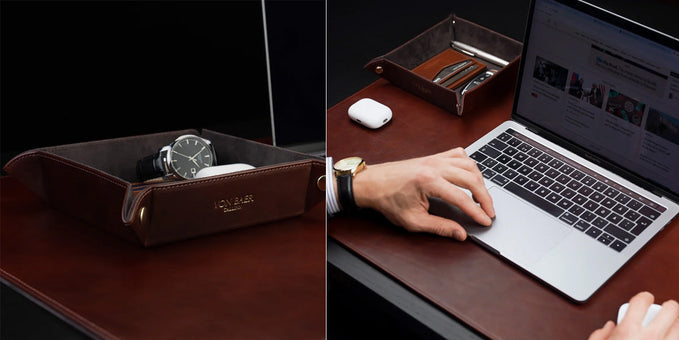Bonded vs Real vs Faux Leather

When in the market for leather items such as bags or furniture, you may come across various types of leather, including real leather, bonded leather, and faux leather.
It can be a bit challenging to distinguish the main differences of these types of leather and to understand what each one of those types of leather is made of.
Real leather is made from animal hides, while bonded leather is a mixture of real and artificial materials.
On the other hand, faux leather is entirely artificial. Understanding the characteristics of each leather type will help you make an informed decision about which one is right for you.
Faux Leather
Faux leather, also referred to as polyurethane or PU leather, is a type of artificial leather that is made from thermoplastic polymer.
If a product is made entirely from PU leather, it is completely vegan, unlike bi-cast leather, which is another type of faux leather that has a layer of polyurethane on top of the fibrous piece of the cowhide left over from the production of real leather.
Real Leather
Real leather is a material made from real animal skin, and is comprised of types like top-grain and full-grain.
Full-grain leather is considered the best grade of leather available and is the upper layer of the animal’s hide that contains natural imperfections, giving it a unique and authentic appearance.
You can learn more about it here: Full grain leather
Bonded Leather
Bonded leather is produced by combining the leftover scraps and fibers from genuine leather production with a polyurethane binder.
The scraps are then bound together using adhesives and placed on a paper backing. To produce the texture of genuine leather, a coating of polyurethane is added and embossed.
Typically, bonded leather contains only 10-20% genuine leather.

The Main Differences
Shopping for leather products can be overwhelming due to the various types of leather available.
It can be a tad challenging to distinguish between the different leathers and understand which type is best for you based on your needs and preferences.
Knowing the differences between real, bonded, and faux leather can help you make an informed decision when purchasing leather goods.
Cost Differences
One of the main apparent differences between real, bonded, and faux leather is the cost. Real leather is the most expensive due to its composition of genuine leather, which is difficult to produce.
Faux leather is less expensive than genuine leather but is costlier than bonded leather. It is easier to produce when compared to genuine leathers.
Bonded leather is in fact the most affordable of the three since it is composed of scrap leather. It is also adhered to a thin piece of paper backing, making it the thinnest of all leather types.
Durability Differences
Real leather is highly durable and can withstand the test of time without cracking or peeling. With use, real leather develops a natural surface patina. Faux leather, also known as PU leather, is not as durable as genuine leather but more durable than bonded leather.
However, it can easily crack and puncture over time and is not breathable. Faux leather is resistant to fading and stains, unlike bonded leather.
Moreover, bonded leather has a short lifespan and can easily peel, scratch, or even flake off after a while because it is made from polyurethane mixed and scrap leather and attached to a paper backing. The color of bonded leather can fade easily in the sunlight.
Related:
- Leather
- Faux leather
- Vegan leather
- Bonded leather
- Genuine leather
- Pleather
- Top grain leather
- Leather types
- Leather guide for beginners
- What is leather patina
- Vegetable tanned leather
- Leather tanning
- What is artificial leather?
- What is full grain leather
Use Differences
While real leather has a natural appearance, its color options are limited and it may have an uneven texture.
On the other hand, artificial leathers like PU leather have a consistent texture and can resemble real leather in appearance and feel. However, they may sometimes appear synthetic.
Bonded leather, on the other hand, is thinner and more obviously artificial than other faux and genuine leathers. Both PU Leather and Bonded leather come in a range of colors and styles, unlike genuine leather, which does not offer much variation.
Sustainability Differences
For some consumers, real leather may be a turn-off due to its non-vegan origins, as well as its difficult manufacturing process and higher cost.
While PU leather production requires fewer resources, the plastics used are not environmentally friendly and do not decompose.
However, if you're seeking a more vegan option, then 100% PU leather is a really good choice. Bonded leather is sometimes considered sustainable since it utilizes leftover scraps and fibers from real leather production, but it may release harmful chemicals over time.
It's worth noting that bonded leather is not entirely vegan, as it can contain up to 20% real leather.
Related articles:
- Where does leather come from
- Mushroom leather
- Napa leather
- Pebbled leather
- Leather grades
- How is leather made
- Italian leather
- How to tell if leather is real
- Buffalo leather
- Suede
- PU leather
- Bonded leather vs Faux leather
- Suede vs Leather
- What is Real Leather
- Pu Leather vs Faux Leather
- Alternative Leather
- Chrome Tan Leather
Maintenance Differences
Real leather's natural absorbency can make it vulnerable to staining and challenging to clean. It is recommended to treat real leather twice a year to maintain its softness and to stop it from drying out, while avoiding the use of abrasive cleaners.
In contrast, PU leather is the easiest out of all of them to clean because it does not absorb liquids. Proper care of PU leather can extend its lifespan. However, cleaning bonded leather can be challenging. Abrasive cleaners or cloths should not be used as they can cause the surface to wear away, crack, or peel.
Other Differences
While scent preferences are subjective, a lot of people dislike the odor of artificial leather types.
PU leather, in particular, may have a noticeable scent of chemicals or plastics.
Bonded leather tends to have an artificial odor, but the added leather may give it a scent that's more akin to real leather. In contrast, real leather has a natural odor that does not seem artificial.
Related:
- Repair cat scratches on leather
- Remove water stains from leather
- Clean leather wallet & remove stains/smells
- Remove ink from leather
- Get smell out of leather
- Remove stains from leather shoes
- Clean suede leather bag
- How to reform a leather bag
- How to maintain leather bags
- Repair cracked leather
- Wet leather
- How to clean leather bag
- How to restore faded leather bag
Conclusion
Ultimately, the choice between these three types of leather boils down to your personal preference, whatever it may be.
Real full grain leather is the preferred choice if you're not looking for a more vegan product.
We hope you enjoyed our article on Bonded vs Real vs Faux Leather.
If you have any questions, leave them in the comments or email Von Baer at info@vonbaer.com.
Browse related leather pages here.

Author: Albert Varkki
Albert Varkki is the co-founder of Von Baer. He understands leather products as a consumer, supplier, and a manufacturer, helping you with the inside knowledge you need, to choose the perfect leather product for you.
We strive for the highest editorial standards, and to only publish accurate information on our website.
Leave a Comment
Your email address will not be published.







